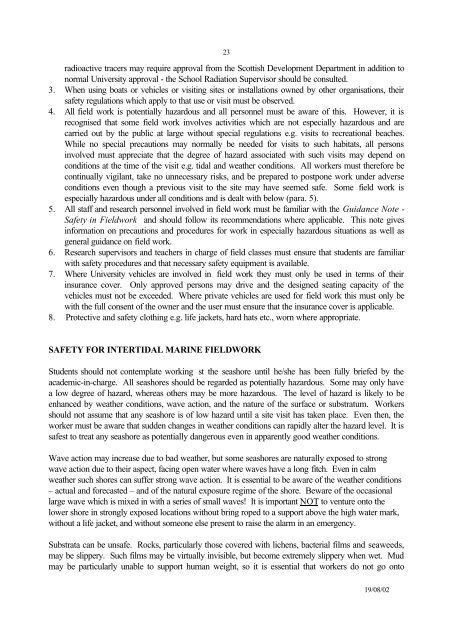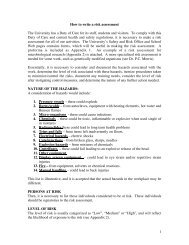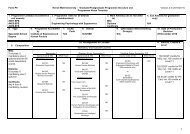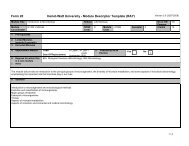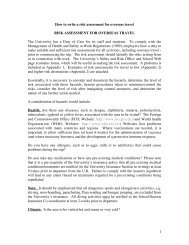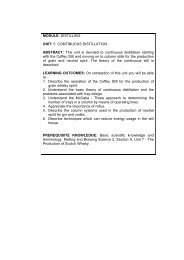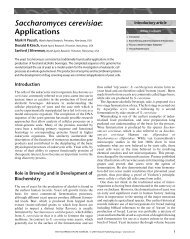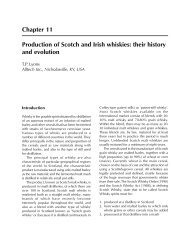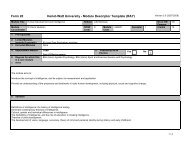SAFETY BOOKLET - School of Life Sciences - Heriot-Watt University
SAFETY BOOKLET - School of Life Sciences - Heriot-Watt University
SAFETY BOOKLET - School of Life Sciences - Heriot-Watt University
You also want an ePaper? Increase the reach of your titles
YUMPU automatically turns print PDFs into web optimized ePapers that Google loves.
23radioactive tracers may require approval from the Scottish Development Department in addition tonormal <strong>University</strong> approval - the <strong>School</strong> Radiation Supervisor should be consulted.3. When using boats or vehicles or visiting sites or installations owned by other organisations, theirsafety regulations which apply to that use or visit must be observed.4. All field work is potentially hazardous and all personnel must be aware <strong>of</strong> this. However, it isrecognised that some field work involves activities which are not especially hazardous and arecarried out by the public at large without special regulations e.g. visits to recreational beaches.While no special precautions may normally be needed for visits to such habitats, all personsinvolved must appreciate that the degree <strong>of</strong> hazard associated with such visits may depend onconditions at the time <strong>of</strong> the visit e.g. tidal and weather conditions. All workers must therefore becontinually vigilant, take no unnecessary risks, and be prepared to postpone work under adverseconditions even though a previous visit to the site may have seemed safe. Some field work isespecially hazardous under all conditions and is dealt with below (para. 5).5. All staff and research personnel involved in field work must be familiar with the Guidance Note -Safety in Fieldwork and should follow its recommendations where applicable. This note givesinformation on precautions and procedures for work in especially hazardous situations as well asgeneral guidance on field work.6. Research supervisors and teachers in charge <strong>of</strong> field classes must ensure that students are familiarwith safety procedures and that necessary safety equipment is available.7. Where <strong>University</strong> vehicles are involved in field work they must only be used in terms <strong>of</strong> theirinsurance cover. Only approved persons may drive and the designed seating capacity <strong>of</strong> thevehicles must not be exceeded. Where private vehicles are used for field work this must only bewith the full consent <strong>of</strong> the owner and the user must ensure that the insurance cover is applicable.8. Protective and safety clothing e.g. life jackets, hard hats etc., worn where appropriate.<strong>SAFETY</strong> FOR INTERTIDAL MARINE FIELDWORKStudents should not contemplate working st the seashore until he/she has been fully briefed by theacademic-in-charge. All seashores should be regarded as potentially hazardous. Some may only havea low degree <strong>of</strong> hazard, whereas others may be more hazardous. The level <strong>of</strong> hazard is likely to beenhanced by weather conditions, wave action, and the nature <strong>of</strong> the surface or substratum. Workersshould not assume that any seashore is <strong>of</strong> low hazard until a site visit has taken place. Even then, theworker must be aware that sudden changes in weather conditions can rapidly alter the hazard level. It issafest to treat any seashore as potentially dangerous even in apparently good weather conditions.Wave action may increase due to bad weather, but some seashores are naturally exposed to strongwave action due to their aspect, facing open water where waves have a long fitch. Even in calmweather such shores can suffer strong wave action. It is essential to be aware <strong>of</strong> the weather conditions– actual and forecasted – and <strong>of</strong> the natural exposure regime <strong>of</strong> the shore. Beware <strong>of</strong> the occasionallarge wave which is mixed in with a series <strong>of</strong> small waves! It is important NOT to venture onto thelower shore in strongly exposed locations without bring roped to a support above the high water mark,without a life jacket, and without someone else present to raise the alarm in an emergency.Substrata can be unsafe. Rocks, particularly those covered with lichens, bacterial films and seaweeds,may be slippery. Such films may be virtually invisible, but become extremely slippery when wet. Mudmay be particularly unable to support human weight, so it is essential that workers do not go onto19/08/02


